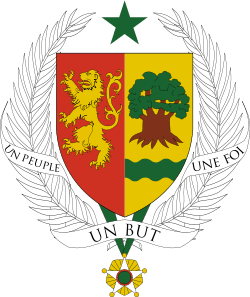Coat of arms of Senegal
| Coat of arms of Senegal | |
|---|---|
 | |
| Details | |
| Armiger | Republic of Senegal |
| Adopted | 1965 |
| Crest | Green star |
| Escutcheon | Per pale, the first Gules a lion rampant Or, the second Or, a baobab-tree proper and in base a fess wavy Vert |
| Supporters | Palm leaves |
| Motto |
Un Peuple, Un But, Une Foi "One Nation , One Goal, One Faith" |
| Orders | Star of the Ordre National du Lion |
The coat of arms of Senegal is the heraldic device consisting of a shield charged with a lion on the left half and a baobab tree on the right, flanked by palm branches and topped with a five-pointed green star at the top.
Adopted five years after Senegal gained independence, it has been the coat of arms of the Republic of Senegal since 1965. Both symbols on the shield had featured previously on earlier Senegalese emblems.
History
Senegal gained independence on 20 August 1960, when it separated from the Mali Federation and became an independent country on its own.[1] It took approximately five years to before Senegal adopted its own coat of arms.[2] It was designed by Suzanne Gauthier, a French heraldist from Paris,[3] in 1965. It incorporated the lion and the baobab tree - both symbols were previously utilised on earlier Senegalese emblems.[4]
Design
Symbolism
The colours and objects on the coat of arms carry cultural, political, and regional meanings. The green star at the crest is identical to the one on Senegal's flag.[4] It alludes to Islam, the religion practiced by 94% of Senegal's population.[5][6][7]
The dexter (i.e. proper right) of the escutcheon features a lion. A national symbol of Senegal,[7] it stands for strength[3] and represents the northern Senegalese ethnic group, which forms the majority of the population. Historically it was a symbol of power for kings, before the French colonised Senegal.[8]
On the arms' sinister, a baobab tree is depicted, which is native to Senegal. Located just beneath it is a green wavy line that epitomises the Senegal River.[3] The order underneath the escutcheon is that of the National Order of the Lion. Both the lion and the baobab tree, which featured previously on earlier Senegalese emblems,[4] are now utilised on the country's two seals.[8] The seal with the baobab tree is used to stamp any acts relating to public administration, while the lion seal is used exclusively by the President for significant acts of state, such as international agreements.[8]
Similarities
The country's motto—"One People, One Goal, One Faith" (French: Un Peuple, Un But, Une Foi)—is exactly the same as Mali's.[4]
See also
References
- ↑ Smith, Whitney. "Senegal, flag of". Encyclopedia Britannica. Encyclopedia Britannica, Inc. Retrieved 24 March 2014. (subscription required)
- ↑ Briggs, Geoffrey (1974). National heraldry of the world. Viking Press. p. 114. Retrieved 24 March 2014.
- 1 2 3 Pedersen, Christian Fogd (1971). The international flag book in color. Morrow. p. 188. Retrieved 24 March 2014.
- 1 2 3 4 Kindersley, Dorling (3 November 2008). Complete Flags of the World. Dorling Kindersley Ltd. p. 76. Retrieved 24 March 2014.
- ↑ Philip, George and Son (26 December 2002). Encyclopedic World Atlas. Oxford University Press. p. 198. Retrieved 27 March 2014.
- ↑ The Report: Senegal 2009. Oxford Business Group. 2009. p. 10. Retrieved 27 March 2014.
- 1 2 "Senegal". The World Factbook. CIA. Retrieved 27 March 2014.
- 1 2 3 "Symbolique nationale". Gouv.sn (in French). Government of Senegal. Retrieved 27 March 2014.